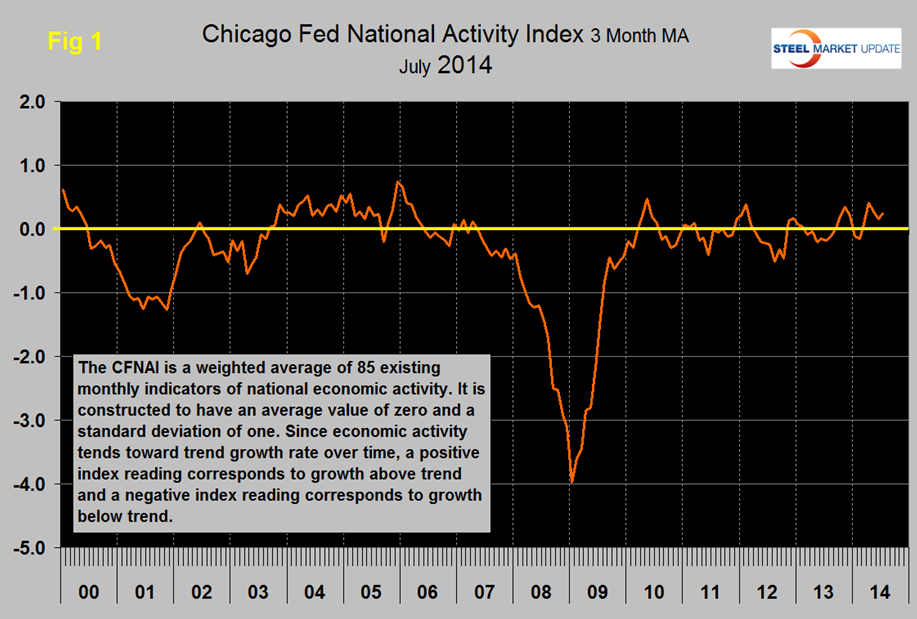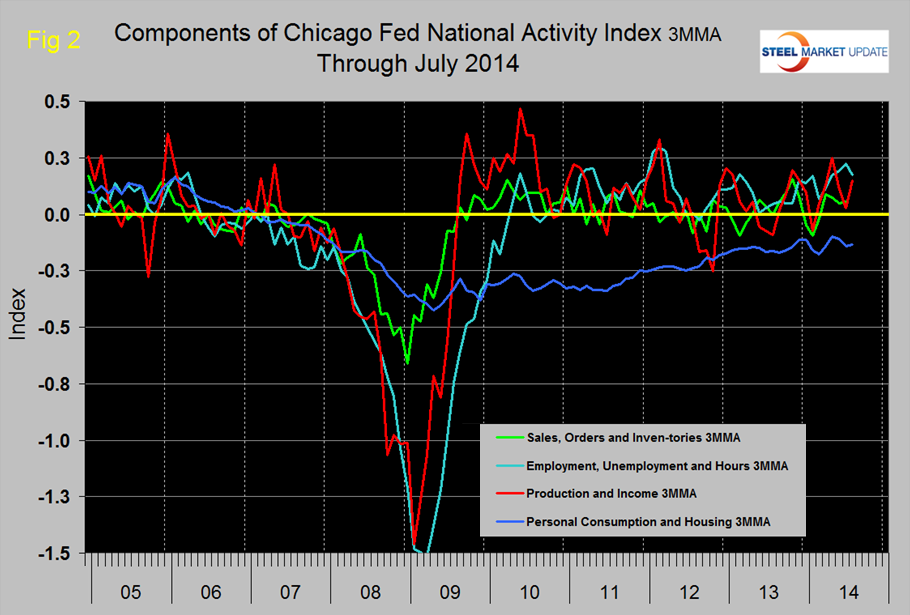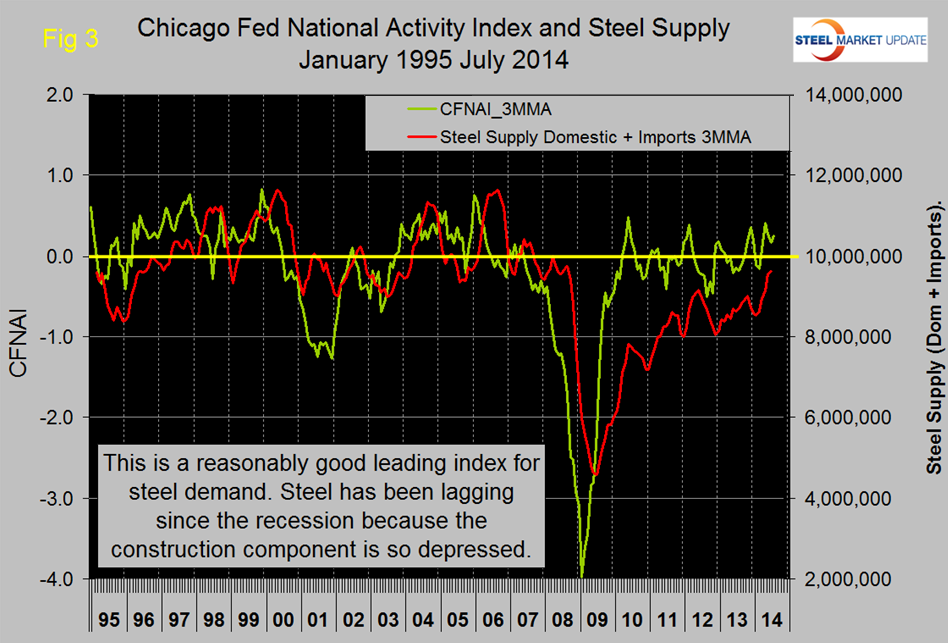Economy

The Chicago Federal Reserve National Activity Index Shows Economic Growth Picked up in July
Written by Peter Wright
August 26, 2014
The following is an abridged version of the Chicago Federal Reserve statement followed by our own graphical analysis. The Chicago Federal Reserve National Activity Index (CFNAI) is an excellent reality check for much of the economic analysis that we routinely provide in the Steel Market Update. An explanation of the Index is provided at the end of this piece.
The official statement reads as follows: Led by improvements in production-related indicators, the Chicago Fed National Activity Index (CFNAI) rose to +0.39 in July from +0.21 in June. Three of the four broad categories of indicators that make up the index made positive contributions to the index in July, and two of the four categories increased from June.
The index’s three-month moving average, CFNAI-MA3, increased to +0.25 in July from +0.16 in June, marking its fifth consecutive reading above zero. July’s CFNAI-MA3 suggests that growth in national economic activity was somewhat above its historical trend. The economic growth reflected in this level of the CFNAI-MA3 suggests limited inflationary pressure from economic activity over the coming year. Fifty-three of the 85 individual indicators made positive contributions to the CFNAI in July, while 32 made negative contributions. Forty-eight indicators improved from June to July, while 36 indicators deteriorated and one was unchanged. Production-related indicators made a contribution of +0.31 to the CFNAI in July, up from +0.05 in June. Manufacturing production rose 1.0 percent in July after rising 0.3 percent in June, and manufacturing capacity utilization rose to 77.8 percent in July from 77.2 percent in the previous month.
Employment-related indicators contributed +0.13 to the CFNAI in July, down from +0.26 in June. The unemployment rate increased to 6.2 percent in July from 6.1 percent in June; however, average weekly initial unemployment insurance claims decreased to 293,500 in July from 315,000 in the previous month.
The contribution of the sales, orders, and inventories category to the CFNAI ticked down to +0.05 in July from +0.06 in June.
The contribution of the consumption and housing category to the CFNAI edged up to –0.10 in July from –0.15 in June. Housing starts rose to 1,093,000 annualized units in July from 945,000 in June, and housing permits increased to 1,052,000 annualized units in July from 973,000 in the previous month.
The CFNAI was constructed using data available as of August 21, 2014.
Figure 1 shows the three month moving average of the CFNAI through July. There has been an erratic though sustained improvement for the last twelve months.
Figure 2 shows the trends of the four main sub-components. The only negative of these four at present continues to be personal consumption and housing.
Figure 3 shows that the CFNAI has historically been a reasonably accurate leading indicator of steel demand, (apparent supply) with a lead time of about six months. This is one of several benchmark indicator that shows steel demand has not recovered to its traditional level since the recession. We believe this to be a measure of the extent to which construction (or lack there-of) is still a drag on steel demand. The good news is that steel supply has been accelerating in the last few months, the bad news, as we have reported elsewhere, is that imports have taken most or all of that improvement.
Explanation: The index is a weighted average of 85 indicators of national economic activity drawn from four broad categories of data: 1) production and income; 2) employment, unemployment, and hours; 3) personal consumption and housing; and 4) sales, orders, and inventories. A zero value for the index indicates that the national economy is expanding at its historical trend rate of growth; negative values indicate below-average growth; and positive values indicate above-average growth. When the CFNAI-MA3, (three month moving average) value moves below –0.70 following a period of economic expansion, there is an increasing likelihood that a recession has begun. Conversely, when the CFNAI-MA3 value moves above –0.70 following a period of economic contraction, there is an increasing likelihood that a recession has ended. When the CFNAI-MA3 value moves above /+0.70 more than two years into an economic expansion, there is an increasing likelihood that a period of sustained increasing inflation has begun.

Peter Wright
Read more from Peter WrightLatest in Economy

Construction adds 13,000 jobs in March
The construction sector added 13,000 jobs, seasonally adjusted, in March, but tariffs could undermine the industry.

Supply chains, end-users brace for impact from tariffs
Supply chains are working through what the tariffs mean for them

ISM: Manufacturing expansion loses steam after two months of growth
US manufacturing activity slowed in March after two straight months of expansion, according to supply executives contributing to the Institute for Supply Management (ISM)’s latest report.

Chicago Business Barometer rose to 16-month high in March
The Chicago Business Barometer increased for the third-consecutive month in March. Despite this, it still reflects contracting business conditions, as it has since December 2023.

Durable goods orders rise again in February
Transportation equipment led the increase, rising 1.5% to $98.3 billion.



